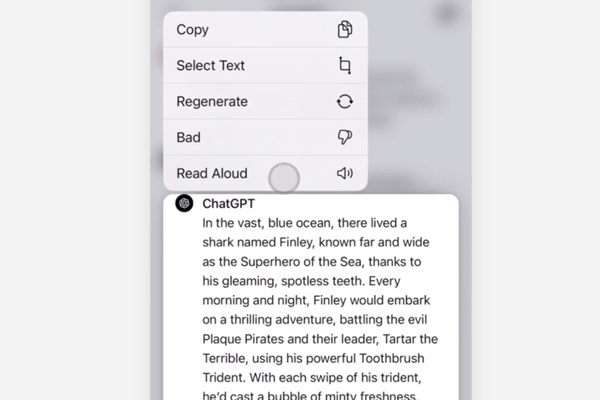ChatGPT Can ‘Read Aloud’ Responses in 5 Voices and 37 Languages
ChatGPT can now read responses to you.
On iOS or Android, tap and hold the message and then tap “Read Aloud”. We’ve also started rolling on web – click the “Read Aloud” button below the message. pic.twitter.com/KevIkgAFbG
— OpenAI (@OpenAI) March 4, 2024
ChatGPT can now vocalize its responses, speaking in the user’s choice of five different voices. The new Read Aloud feature creates an audio performance of ChatGPT’s answers in 37 languages, automatically detecting which language is being used and pronouncing the words accurately.
ChatGPT Read Aloud
Read Aloud works with both GPT-4 and GPT-3.5 LLM. Users can set ChatGPT to speak all of its responses or can manually trigger the audio for any of ChatGPT’s answers. Those using ChatGPT through a web browser can click on the speaker image at the bottom of the text, while those using the ChatGPT mobile app can press on a message to start, pause, or rewind the audio playback. ChatGPT can converse using any of the five available voices synthesized from professional voice actors into AI models.
This isn’t ChatGPT’s first foray into voice interactions. OpenAI added its speech recognition system Whisper to ChatGPT in September, enabling the chatbot to understand a user’s speech and respond vocally. However, that was a purely audio experience, with no written text. Read Aloud goes one step further by reciting written responses. OpenAI has suggested the spoken format could be beneficial for those multitasking or who need their hands free.
Text-to-speech features are starting to become a standard facet of generative AI chatbots, with Anthropic recently enhancing Claude with a similar ability. Read Aloud also looks a lot like the SoundHound generative AI chat app created almost a year ago, which leveraged third-party LLM APIs and SoundHound’s voice AI tech to produce a similar effect.
Read Aloud fits in with the other ChatGPT upgrades and improvements rolled out over the last few months in between enormous changes like the custom GPT Store. They all seem aimed at reducing any friction and widening options for ChatGPT users. Most recently, ChatGPT added a memory setting to tailor how it interacts with users based on previous conversations. Recalling preferences and personal information reduces the need for repetition by the user at the beginning of every conversation. That followed the ability to invoke custom GPTs during a conversation, chat archiving, and the release of new models designed to make ChatGPT work harder. All of which builds on earlier features like online search and image and document analysis.
Follow @voicebotaiFollow @erichschwartz
OpenAI Turns ChatGPT into a Voice Assistant That Can See and Understand Images and Speech
SoundHound Launches Generative Chat AI Voice Assistant Platform and Mobile App









